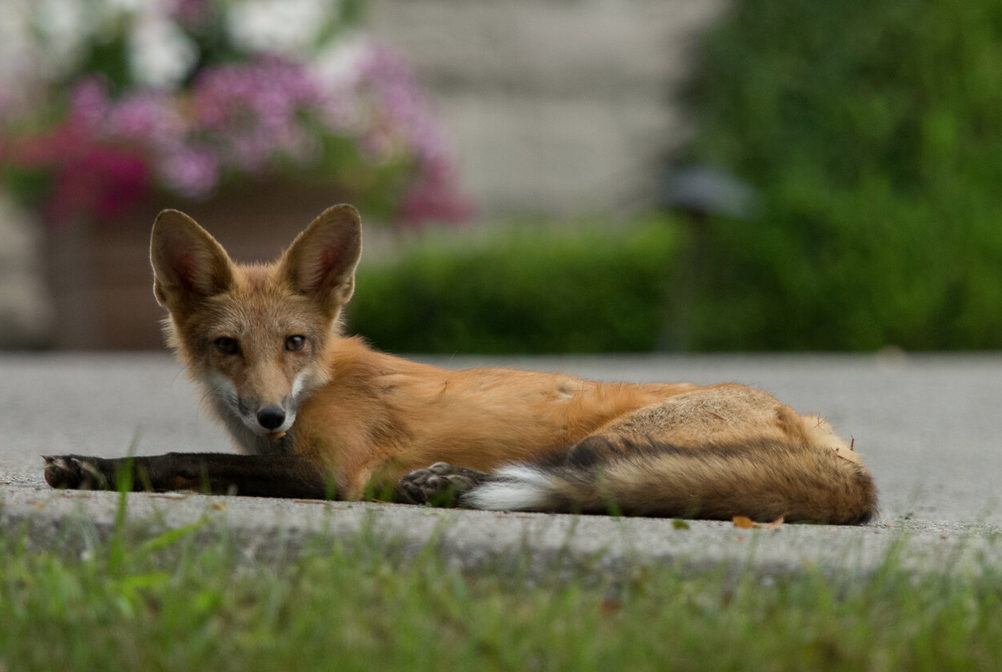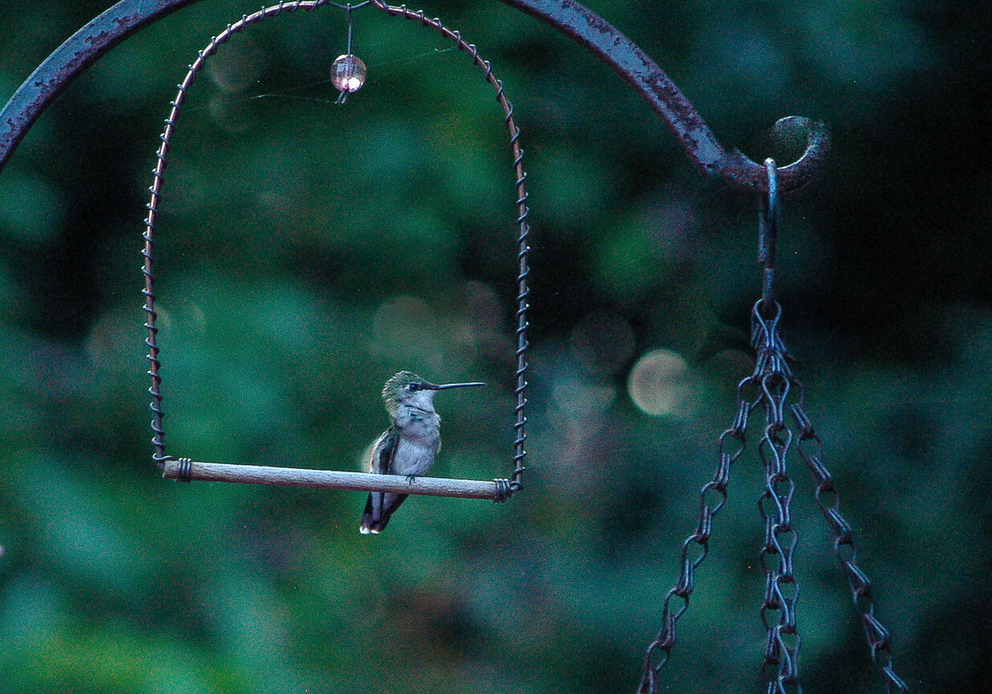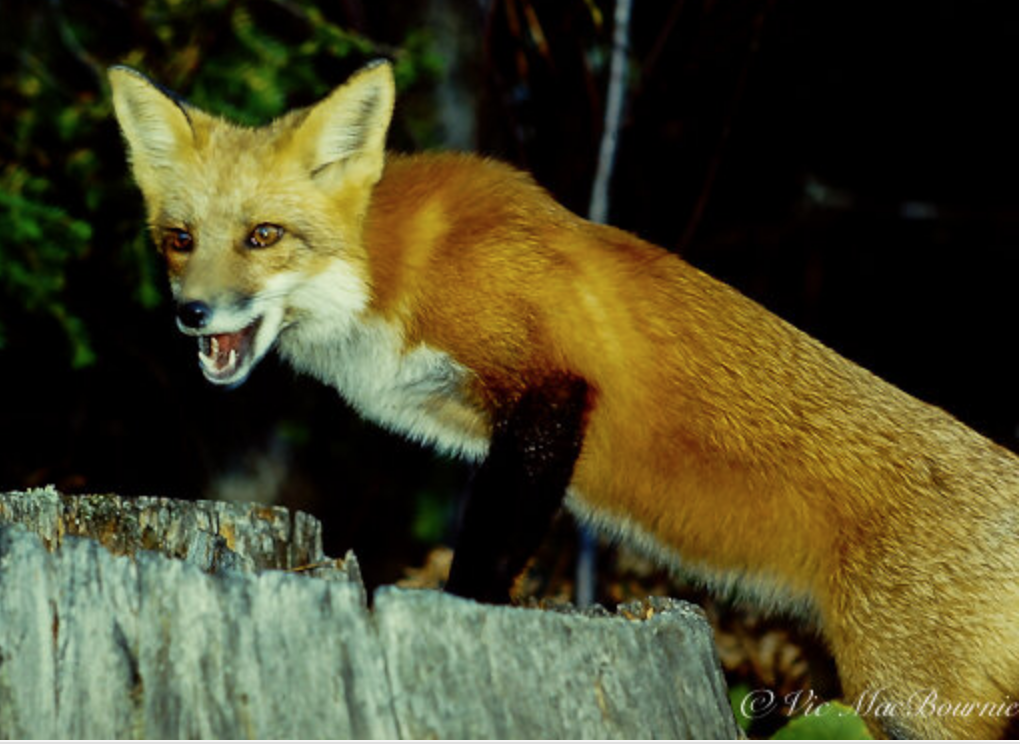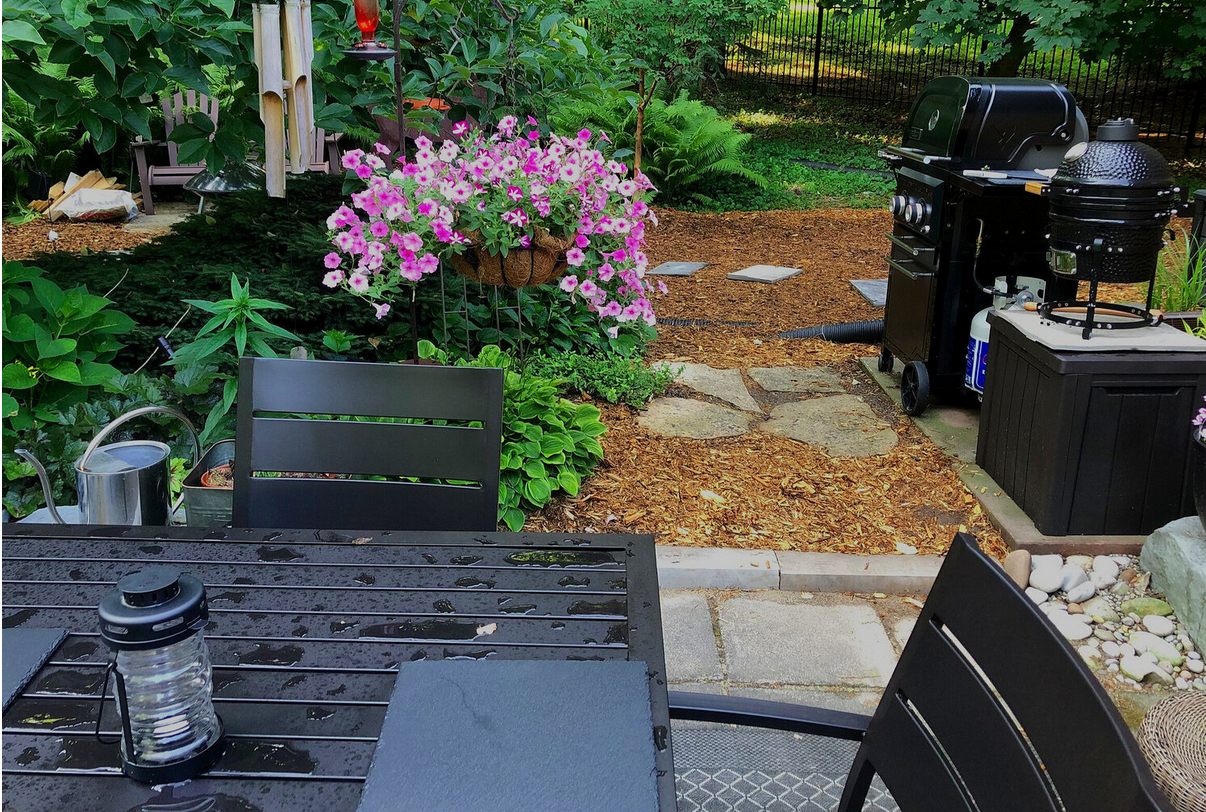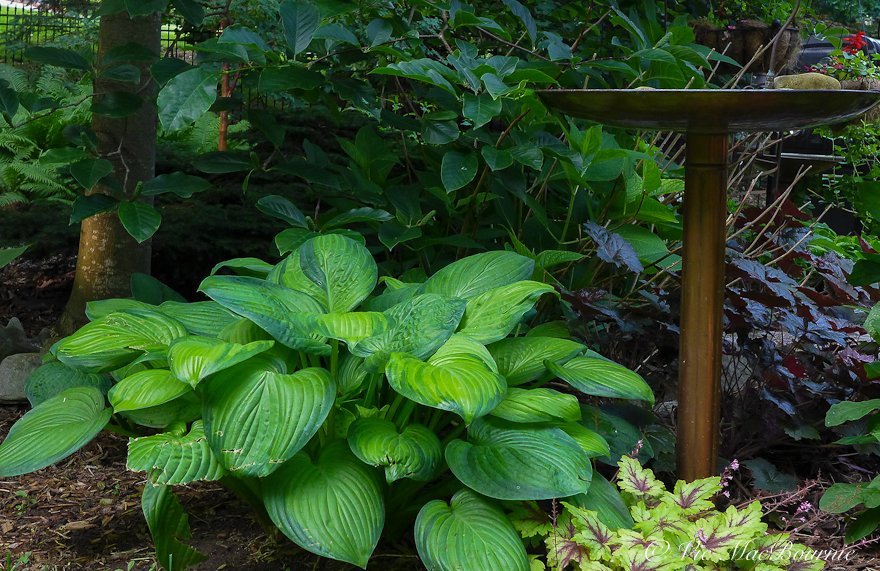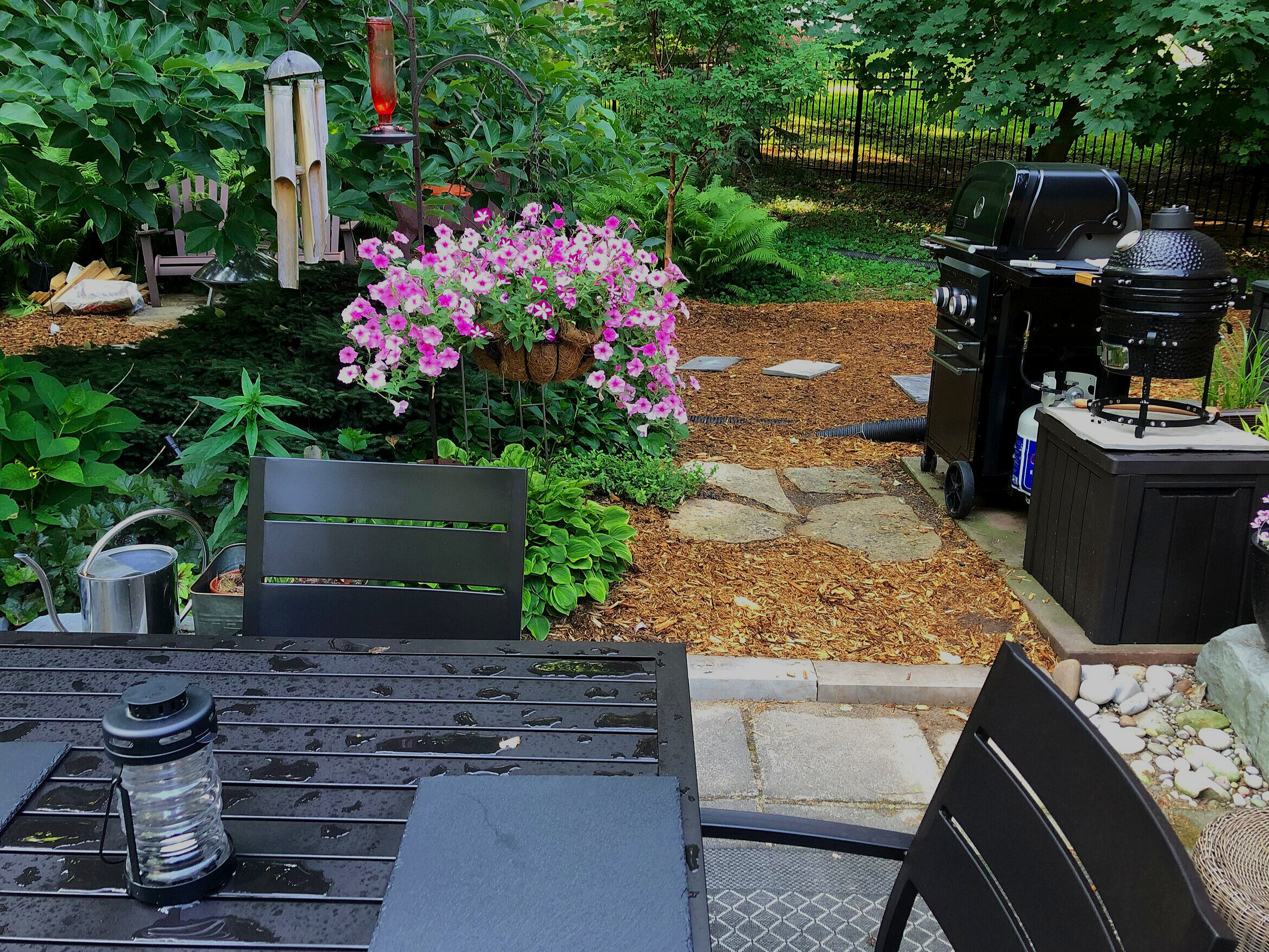Welcome the urban fox: The ultimate rodent controller
Urban foxes are common throughout North America and are important predators in the control of rodents in our woodland gardens. Here are tips to help gardeners encourage them and help them survive and prosper in our gardens.
Do fox control mice and rats?
Our first fox sighting came on Day 2 after moving to our new, old home some 22 years ago.
My daughter and I were out for a stroll in the woods surrounding our home when a fox appeared on the path right in front of us, looked at us and went on its way without a care in the world.
Not long after, a fox visited the backyard bird feeder where it scored a black squirrel pretty much on a daily basis for several weeks. Every morning at breakfast, my daughter and I would see the fox appear out of nowhere, chase down a squirrel across the yard, catch it, and with a hard shake immobilize it, before carrying it back to its den no doubt for its kits.
Needless to say our squirrel population was kept nicely in check with the Red Fox around.
While squirrel is certainly on their list of preferred food, there is no question that mice and other rodents make up a high percentage of a fox’s diets throughout the year, especially in urban areas. Studies show that urban fox feed predominantly on small mammals, particularly rodents like rats, mice and voles. Rabbits are also among their preferred food choice. Together, these can make up about 50 per cent of their diet.
Our cute little neighbourhood fox taking a rest on a driveway before an evening of hunting. July is a difficult time for fox, and it shows here in the fox’s skinny body .
Ever heard a fox scream. It’s terrifying but fascinating. For more on why foxes scream, check out my post here.
But then they pretty much disappeared for years. Foxes became rare around these parts, apparently decimated by mange.
But they’re back and I couldn’t be happier.
Not sure our local rodent population is as excited about their return as I am, however. Urban foxes help control small mammals, particularly rodents including rats, mice and voles. Squirrels and rabbits are also on the menu to a lesser degree.
This alone is reason enough for gardeners to love these little canines.
Check out my earlier articles on Why do Foxes Scream and Why Foxes steal from our gardens
We have been noticing foxes in the area again for the past two years. This winter I noticed a fox at a neighbour’s property in mid winter. It greeted my dog and I after we returned for a walk. It was in January, about the time of peak mating period. This is about the time these usually quiet little fellas become quite vocal often screaming and barking as the males roam the neighbourhood looking for partners.
When do fox begin breeding?
By February the females are pregnant and begin clearing out den sites in and around our gardens (under decks, sheds and large tree stumps).
Cubs are usually born mid-march, totally deaf, blind and in need of their mother’s constant warmth. By April the cubs emerge from their dens and start eating solid food. By May the den is an active place, especially at dawn and dusk when the parents are busy bringing the growing kits food.
This photo shows on of our neighbourhood foxes killing its prey after pouncing on it in the garden. It’s not a pretty site to watch but our gardens can be good sources of food for neighbourhood foxes.
What do foxes eat?
Foxes are actually extremely opportunistic, omnivorous predators. Besides rodents, Fox will happily feed on invertebrates, particularly various beetles, butterflies and moths as well as earthworms, grasshoppers and crickets. And those pesky garden snails and slugs are also on their menus. Spiders too, are on their list of good eats.
To a lesser degree, Fox will eat frogs and small snakes.
Birds also make up a large part of a fox’s diet, especially in the spring and early summer when foxes are feeding their hungry cubs.
Some foxes have even been known to climb trees in search of prey or fruits and nuts.
Fox kits hanging out a their roadside den.
In an urban garden, there is no doubt that bird feeders provide the perfect opportunity for a fox to easily satisfy most if its nutritional needs. Everything from rats and mice to squirrels, chipmunks and a host of birds gather around the feeder, often letting their guard down just enough to become dinner for the fox.
Being the ultimate opportunist, Fox will feed on whatever is abundant in your area. Whether that’s bugs or rats, the fox will play an important role in keeping populations in check.
Do fox eat worms?
A 1980 study showed that worms played a major role in a cub’s diet during August and September as the cubs, born in March, begin using their own hunting skills to catch worms. The study found that during some months, earthworms may account for more than 60 per cent of a fox’s calorific intake. The study estimated that it would take approximately 120 worms in a night to meet a fox’s caloric needs.
Do fox eat larger animals than mice and rats?
In other areas, hedgehogs, deer, otter, European badger, opossum, raccoon, porcupine, and even wild boar are on the menu. Fox remains have also turned up in their diets as have domestic cat, but many of these animals are expected to be the result of scavenging.
Do fox eat plants and berries?
It’s not all about meat, however. Fox will happily eat a range of plant material, especially fruits, both wild and cultivated. ( I have noticed that my blueberries are disappearing just as they begin to ripen.) Blackberries, raspberries, cherries, apples plums, grapes and even nuts are important foods for the fox as winter approaches. Studies show that fruit accounts for about 10 to 30 per cent of the diet.
And not unlike our domestic canines, grasses, sedges and various tubers find their way into the diet of most foxes.
For a more detailed look at the fox diet, go to Wildlife Online.
The main picture that accompanies this blog was taken at the end of July and it shows. At this time adult fox are often showing the strains of three months of having to provide for their growing cubs. It’s during this time that the fox begin to slow the feeding of their cubs and actually start competing for food with them. This is a dangerous time for the young foxes that are often forced to go out on their own to explore and fend for themselves.
If they survive, they begin to put on their winter coats in September and October in preparation for a long, hard winter. Male cubs leave the den area in late fall, early winter to look for their own territories.
And it all begins again.
How can the Woodland gardener help foxes?
It’s clear that providing a natural area, free of insecticides, that provides a combination of food sources including small rodents, fruit and nuts, while also providing water sources and potential den sites, is a goal all woodland gardeners should strive for. The brush pile we talked about in an earlier post becomes a hunting ground and a potential denning site for fox.
On-ground water bowls become a life-saving source of fresh water during a heat spell. Our humus-rich soil provides homes to insects and a source for earthworms. Leaving debris around the garden like branches and leaves give rodents like mice a place to live and, in return, a source of food for predators such as fox, owls and even snakes.
And, if our properties can only provide a few of these resources, we can provide a green island in a neighbourhood of green islands where a predator like the fox can exist.
We can be the ark (Acts of Restorative Kindness) that Irish landscape designer Mary Reynolds urges in her book The Garden Awakening and on her website, even if our gardens are small islands in a sea of islands.
Are hummingbird swings worth buying?
Adding a hummingbird perch close to a favourite feeder or nectar-rich plant provides the perfect resting place for hummingbirds and an ideal place to photograph the little guys when they are not flitting about.
Perch is ideal for great garden wildlife photography
I don’t know who has more fun the hummingbirds or me, but every morning it’s a swinging good time.
Me with my coffee, Holly resting on her table, and the hummers taking turns on the swing as they make their way to one of the many feeders or native plant groupings in the garden.
Do hummingbirds use store bought swings or perches?
We’ve had the swing for about three years. At first, the hummingbirds didn’t know what to think of it and pretty much left it alone. But it wasn’t long before they took to it and made it one of their favourite landing spots in the garden.
If you are only used to seeing hummingbirds hovering at flowers or a feeder with their little wings buzzing away at more than 50 beats per second, the perch will give you the opportunity to observe them up close preening their feathers and keeping a watchful eye out for competitors.
If you look closely, you might get a good look at their long tongues that they use to lick up the nectar from tubular flowers.
Perches are available at many specialty bird stores and online sources. I purchased ours from Wild Birds Unlimited, but they are also available at Veseys and Walmart as well as Amazon.
The perch is also an excellent spot to set up a camera to photograph them at rest.
Once the hummingbirds start using the perch on a regular basis, you can set a camera up on a tripod and capture some stunning images of the little guys.
Garden wildlife photography can be very rewarding, especially when you can guide the wildlife to where you want to photograph them. You don’t need specialized camera equipment once you get them comfortable landing on the swing in your vicinity.
A good compact camera with a built-in telephoto lens is all you really need. If you are interested in getting more information, check out my post on the Best camera and lens for garden wildlife photography.
Don’t be surprised if they decide the camera is a good landing spot.
For more on hummingbirds in the garden, check out the following posts:
• How to help Hummingbirds during migration
• Five tips to attract hummingbirds
• How long do hummingbirds live
• Where do hummingbirds go in winter
The swing is attached to one of our large, iron plant hooks just above a hanging container filled with Proven Winners Supertunia Vista Bubblegum and just to the right of a hummingbird feeder.
Certainly a lovely spot to go for a swing at any time of day. And if you are looking for an elegant feeder to complement the copper swing, you could do worse than this piece of garden art.
The swings can be purchased commercially or, if you are handy and up for a challenge, can be put together in an afternoon DIY project with some copper wire, beads and either a small branch or a dowel purchased from a hobby store.
Ours is made of a thick copper wire forming the main structure of the swing with a thinner copper band of wire wrapping all around the main wire. The smaller wire helps to hold the small dowel in place for the hummingbirds to sit on and twists up to the top where it holds a lovely red glass bead. I’m not sure if the bead is just for decoration or meant to attract the birds to the swing, but it’s a nice touch.
In case you didn’t know it, hummingbirds are real swingers. Researchers say that hummers spend about 80 per cent of their time perching. So a good perch that swings, is a real find for these little guys.
Now if you know anything about hummingbirds, you know they can be very territorial. Especially when there is a fresh supply of nectar.
The swing is the perfect spot to sit and rest from the enormous task of guarding the food supply, whether that is a batch of homemade nectar (4 parts boiled water to 1 part granulated sugar) or a nectar-rich flowering plant.
Don’t forget to use native flowers in your garden to attract hummingbirds. The plants offer another opportunity to photograph the birds once they begin including the native plants on their feeding routes.
We have located our swing right next to the patio where we can watch the birds on a regular basis. The more they get comfortable with you, the longer they will sit on the swing and pose for photographs.
I can’t imagine going out in the morning and not having the perch for the hummingbirds. Sure they can use a twig from a nearby tree, but providing the perfect spot for them brings them close and allows me to share my coffee time with our little garden friends.
And isn’t that why we have our gardens?
This page contains affiliate links. If you purchase a product through one of them, I will receive a commission (at no additional cost to you) I try to only endorse products I have either used, have complete confidence in, or have experience with the manufacturer. Thank you for your support.
Why do foxes steal from our garden? Fox got my Croc
Somewhere in my neighbourhood is a lost and lonely Croc. It disappeared during an overnight crime spree carried out with great stealth. Our dog saved one by her barking. I am worried about the other.
Closing in on the crime
Somewhere in my neighbourhood a lost Croc is scared, lonely and likely getting chewed on.
I rescued its sibling on a patch of parched earth in the middle of our lawn.
The saga began when I woke up, looked out back to ensure it was safe to put Holly out for the morning. Just two days earlier, she got skunked and I wasn’t going to let that happen again.
(You might want to check out my other articles on foxes: Why Foxes Scream and The urban fox and how it controls rodents like mice and rats.
In the middle of the lawn, what looked like a dead squirrel lay motionless.
Earlier, Holly had been barking at the window. I imagined the barking scared the fox who dropped the squirrel. I went outside to move the dead animal.
Young foxes like to use “toys” such as shoes and gloves to learn life skills including catching prey.
When I stepped out the back door I noticed my old Crocs were nowhere in site. I remember leaving them just outside the door after watering the garden the night before.
Barefoot, I walked out to the middle of the grass. There it sat, motionless. My old Croc, all alone in the parched grass. No doubt, left there in haste by our friendly neighbourhood fox on its regular morning visit.
This wouldn’t be the first time a fox decided to take something that was not theirs. Foxes have been known to make a habit out of stealing people’s shoes. In fact, some have even become famous for their shoe fetishes.
Take the shoe-loving foxes from a neighbourhood in Japan that pilfered 40 pairs of sandals before being nabbed in the act of the crime after a six-hour police stakeout.
This fox is hunting for mice in a grassy area of the garden.
The pair of sly foxes were discovered after police received reports of footwear mysteriously disappearing from eight households in Nagaokakyo, about 235 miles (380km) west of Tokyo.
Five police officers were involved in the stakeout that ended with the discovery of two foxes who had made their home in the garden of an empty house, with 40 pairs of shoes scattered around a burrow.
In a German town, a fox was responsible for stealing more than 100 shoes.
In England, 50 shoes were found along a path near a fox den – runners and work boots seemed to be the favourites.
So I am not alone. My Croc joins a long list of missing shoes stolen from yards while their owners slept soundly in their beds, totally unaware of the crimes happening all around them.
What makes them want to take our shoes?
From a website on foxes: “A wide range of objects can be found close by a breeding den – besides pieces of paper, plastic and bone there is an array of leathergoods like chewed shoes, gardening gloves or balls. Fox cubs have used them to play with. These “toys” are apparently presented to the young cubs by adult foxes. Later, older cubs bring them back from their own adventure tours.”
The same site describes how fox cubs use the “toys” to play with their siblings and use various “objects to train their hunting skills such as how to catch and handle their prey.”
So, some advice to my fellow gardeners: Don’t leave shoes, including your favourite Crocs or gardening gloves (especially leather ones) outside overnight. Consider putting away any other articles that you think might be a score for the neighbourhood fox.
We don’t need any more orphaned Crocs.
Be sure to check out my other articles on foxes: Why Foxes Scream and The urban fox and how it controls rodents like mice and rats.
Tips and ideas on how to de-skunk your dog
It all happened so fast. And it can happen to you and your dog if you are not careful. Here are some tips to deal with a skunking and ideas to help stop if from happening again.
Taking the stink out after getting skunked
It all happened so fast.
Holly and I go out every night at around 11 for her final pee. She loves it because she knows there’s a treat at the end. Maybe even two. Well, usually at least two.
It’s a quick in and out, no problem.
Not knowing what awaits us as we step outside, Holly is always on a leash and usually just a few steps in front of me until I’m sure the coast is cleared. The main back light is turned on to supplement the many solar lights and anything that is out there is given ample warning that we are coming out.
I guess no one told Pepe Le Pew the routine. The skunk was hiding behind a large rock on the edge of the patio probably busy digging for grubs. He was just steps from the back door. I think Holly was as surprised to see him as he was to see Holly. All I saw was Holly standing over the little guy before a flash of a black and white tail prompted me to yank the leash back and get her inside.
Then it hit me.
A skunk looking for food in the early evening.
Skunk spray is a form of sulfur. that is released in an oily form. The oil can stick to many surfaces and permeates everything it touches. Once released, the skunk smell fills the air and seeps into everything. It’s a good idea to close all exterior doors and open windows to keep the smell outdoors. The smell can even permeate skin and it’s not unusual to have the odour in your mouth and nose for a period of time. Is it any wonder that, if not treated properly, a dog can carry the smell for up to two years? Especially when its fur gets wet. Just ask a dog groomer. Most will not even take a dog that has been sprayed recently for fear of contaminating their grooming facility.
Holly’s smell was ripe and spreading through our small back landing. I called out for help. Paper towels please and plenty of them.
Be aware that skunks are particularly active in mid Feb. when you might not expect to come across them. This is their mating time and they are often seen during the evening but also during daylight hours roaming around even when there is significant snow on the ground. For more on their Valentine adventures, check out my post here.
Probably not a good idea to bring her inside immediately after getting skunked but I wanted to check her eyes. It’s important to check their eyes; if they're irritated or red, immediately flush them with cool water.
Her eyes seemed fine.
You know that skunk smell you get when you pass one that has been hit on the road, It was nothing like that…
Pungent. Not nice at all.
It wasn’t Holly’s first encounter with a skunk and it surely won’t be her last. After wiping her down as best as I could, we put her and her friend Monet (the cat) in the basement for the night. I felt sorry for both of them, but that’s all we could do at that time.
I would deal with her in the morning.
At first light I was up to take the little stinker outside. I expected the worst when I opened the door to the basement. I was greeted by the cat and dog together at the foot of the stairs. Not sure if Monet felt sorry for Holly or the smell wasn’t bad enough to keep these two buddies apart.
Turns out Holly was able to dodge a bullet. Either she sidestepped the worst the skunk had to offer or the skunk was still a baby and didn’t pack enough punch to make it stick.
Either way, the back entrance seemed to get the worst of it all. A complete cleaning with a Lysol cleaner and then swiffer wet, some scented candles and a diffuser running Refresh from Sage, and it’s liveable again.
Commercial de-skunking products such as Natures Miracle Skunk Odor Remover should probably be your first step to deal with the problem quickly.
Other highly rated products include: Van Den Heuvel’s R86 Industrial Odor Eliminator which is non-toxic and biodegradable. Not only does it eliminate just skunk odors, its combination of more than 30 different essential oils and natural ingredients, can eliminate several odours and is safe to use around children; Bodhi Dog Pet Deskunk Spray Odor Eliminator advertised as containing a combination of essential oils and useful on flat areas both in the home and outdoors; Skunk-off Liquid Soaker, a fast acting solution also useful on hard surfaces around the home; De-Skunk Odor Destroying Shampoo.
But being ill-prepared, I had to make a quick trip to the pet store for some de-skunking shampoo. After a good bath in her bottle cap pool, she’s almost as good as new.
This skunk was wandering through the garden one evening showing off its beautiful tail.
Lessons learned from dog getting skunked
First lesson: Be extremely careful when taking your dog out at night. A combination of solar lights and the back light is good, but it’s not enough in a garden where skunks can be hiding behind plants, rocks or containers. Skunks don’t run fast, so give them time to clear the area. Maybe include a powerful flashlight at the back door for a pre-surveillance before going outdoors with the dog.
Second lesson: Be prepared. There’s not much you can do at 11 pm to deal with the situation if your cupboards are bare of the essentials to de-skunk your dog, or yourself, for that matter. Get some supplies (commercial de-skunkers, old towels, distilled water, rubber gloves, a face mask), put them in a box and have them ready for the big night so the skunking repercussions can, at least, be minimized.
Third lesson: Keep the area around the back door relatively open to lessen the chance of surprising the stinky ones. Always take your dog out on a leash. Despite the leash, she still got skunked. I can’t imagine letting her out on her own. Maybe yanking her back when I saw what was happening was enough to keep the damage to a minimum.
There are several commercial de-skunking remedies available that are simple to use and provide some immediate relief from the odour.
A common DIY concoction comes highly recommended by the humane society
Mix together:
1 quart of 3-per cent hydrogen peroxide (available at most pharmacies)
1/4 cup baking soda
1 teaspoon liquid dishwashing soap preferably Dawn ( highly recommended by wildlife rescues.)
The hydrogen peroxide strips the skunk’s oil from your pet’s coat, and the baking soda helps to neutralizes the smell. Keep the formula away from your pet’s eyes, mouth, ears and nose and do not let your dog swallow any (it will cause immediately vomiting.)
Pop on some rubber gloves and wash your dog with this solution as soon as possible after they’ve been sprayed.
This DIY mixture CANNOT be stored for later use. The components in this mixture could explode if left in the bottle.
Clean and Rinse: Rub the mixture through the dog’s fur, but don’t leave it on too long (peroxide can bleach fur). Rinse thoroughly.
Shampoo: Next, wash your dog with pet shampoo preferably a de-skunk shampoo and rinse thoroughly. Towel-dry the dog and leave it in a warm dry area. Now is not the time to leave it out in the cold or in a cold garage unless there is a bed and a heater nearby. By now, the smell will be either completely gone or, at best, just slightly stinky.
Wash towels and human clothing separately in a normal wash cycle.
This page contains affiliate links. If you purchase a product through one of them, I will receive a commission (at no additional cost to you) I try to only endorse products I have either used, have complete confidence in, or have experience with the manufacturer. Thank you for your support. This blog would not be possible without your continued support.
Backyard or Garden: Putting it all together
Creating outdoor living and entertaining with a backyard woodland garden begins with proper planning, but the results can be a truly enjoyable, private space that encourages outdoor living and a truly enjoyable experience.
Open Garden Tours are an opportunity to experience beautiful gardens
I love Open Garden Tours.
They provide us with an opportunity to peek behind the back gates of some of the finest gardens in our area.
They inspire us to make our gardens better, to explore new approaches and to contemplate what we think makes a garden exceptional.
Over the years, garden tours have provided me with endless inspiration. I particularly enjoy touring gardens designed and created by homeowners rather than landscape professionals, but some of the most remarkable gardens I have experienced were created by professional landscapers.
During a tour a few years ago, I remember visiting many exceptional gardens of multi-million dollar homes. Most were created and maintained by high-end professional landscape companies.
One in particular stood out – not because of what it was, but what it could have been.
Everyone who walked through the home’s swanky front gates were excited to see what awaited us as we strolled into the back of the magnificent property.
No-one expected the disappointment that greeted us - a sea of concrete, a large pool and a small cantilevered deck overlooking a woodland. That was it. I don’t recall even a single container planted up on the stairs leading to the pool.
The owners were obviously proud of their yard. They stood outside greeting visitors who offered polite praise of the back yard pool before scampering out as quickly as possible. It didn’t help that, for comparison, most of us had just toured some of the finest gardens in the area, but it was impossible to overlook the fact that this could hardly be described as a “garden.”
I’m sure there were visitors who were impressed with the yard.
The “gardeners,” however, were aghast.
And so, the question remains: What makes a garden exceptional?
To many – these homeowners included – a backyard is a place to entertain friends and family. To others, a garden is a quiet retreat under a canopy of magnificent trees.
You may have noticed that I referred to one as a “backyard” and the other as a “garden.”
Today, as urban backyards become increasingly smaller, gardens are being replaced by yards. Large decks, patios, massive outdoor kitchens, television screens and hot tubs are competing with perennial gardens, flowering trees and shrub borders for our attention.
In most cases, the plants are losing out.
Gardens are being forced out by backyard entertainment areas in many urban neighbourhoods. Obviously, this is not a good thing. Natural corridors through neighbourhoods, so vital to mammals, birds and reptiles, are shrinking. In many new neighbourhoods we are left with mini-islands of green space not large enough to sustain any meaningful life for native fauna.
It doesn’t have to be that way. With proper planning we can have it all – a place to entertain family and friends as well as natural areas in the garden for wildlife.
Let me be bold enough to make a suggestion to new homeowners: Begin with trees, not the latest high-end BBQ.
The greatest investment you can make in your yard is a small tree that will grow into a magnificent specimen, providing privacy, shade and beauty year round. For the price of a high-end BBQ, you could purchase enough young trees, shrubs and plants to set the foundation for a lovely garden that will increase your property value ten-fold in a few short years – just about the time when you’ll have to replace that BBQ with a new model.
Unlike consumer products, trees get better with age.
I’m not saying don’t buy a BBQ, build a deck, add an overhead structure or lay a new patio. I’m just suggesting you start with a garden plan whether you draw it up yourself or sit down with a professional landscaper.
Once the bones of your garden are in place, then it’s time to look at possible entertainment areas in your yard.
Surrounding these entertainment areas with gardens provides the privacy that is so sought after in many of today’s modern subdivisions. One tree may be all you will need.
Creating the garden and privacy first will surely entice you to want to spend more time outside. Even if you think a garden is not your thing, I guarantee you the experience of eating under the limbs of a tree, it’s branches festooned with outdoor lights, will go a long way to change your mind about the need for a garden.
My wife and I recently bought into this idea big time. Given the stay-at-home world that Covid brought with it, we decided it was a good idea to invest in a little outdoor luxury. We purchased not one, but two barbecues – a small, charcoal unit and a two-burner propane unit. We also added an outdoor dining table and chairs with the expectation of staying home all summer and enjoying our garden in the midst of the pandemic.
It’s already proven to be a great investment. Dining outside couldn’t be more enjoyable. French toast for breakfast on the griddle of our new Vermont Castings propane barbecue, and outstanding chicken wings from the grill of our mini Louisiana Kamado-style grill has made restaurants and take-out a thing of the past. We have a summer of new recipes ahead just waiting to sample.
Spending time outdoors couldn’t be more enjoyable. There is something very relaxing about watching nestlings take their first flights while chipmunks chase one another around your table during morning coffee.
The yard and garden coming together as one. That’s a goal we need to work toward. That just may be the recipe for happiness.

